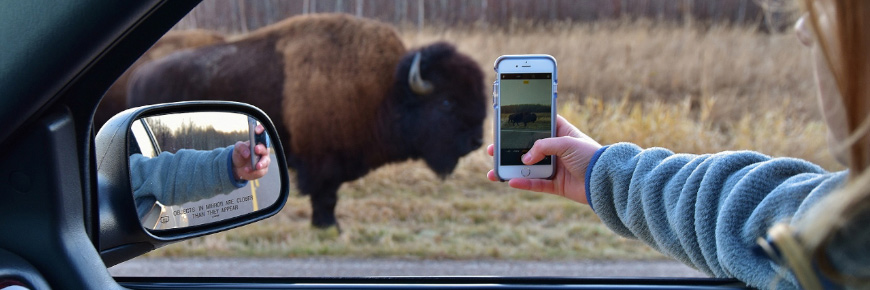
Be bison wise
Elk Island National Park
Bison are wild animals. Even though they look docile, bison are dangerous, unpredictable, and may charge without warning. Keeping wildlife wild is a shared responsibility. Visitors have a responsibility to be informed and to explore the park in ways that ensure both visitor and wildlife are safe.
Follow these tips to enjoy each bison encounter safely at Elk Island National Park:
In a car
- Drive slowly and bison will move out of the way
- Do not honk, become impatient or drive aggressively. Attacks on vehicles are rare but can happen
- Stop and view bison from a distance only if safe to do so. Stay in the vehicle. Watch for a few moments, take a quick photo, and move on
On foot or on bicycle
- Be aware of surroundings and watch for wildlife
- When approaching blind corners, proceed slowly in case a bison is just out-of-sight
- Cyclists’ pair up with a motor vehicle to navigate past a bison in the ditch. Never ride through a herd on the road. Wait for the herd to move on or turn around.
- Startled bison often run away, then stop and look back. Detour around any bison that remain in the area. Wait for bison to move, walk around the bison leaving space for them to escape, or back away slowly
- Do not hike, bike, recreate, or cycle with ear buds. Pay attention to surroundings
- Do not approach a bison closer than 100 metres and never try to chase or scare bison away

Use your thumb – what does 100 metres look like?
Hold your fist straight out in front of you and raise your thumb. Cover the bison (who is standing sideways) with your thumb. If the bison is totally covered you are about 100 metres away, a safe distance. If your thumb does not cover the bison, retreat slowly.
Use extra caution:
- In May and June when bison cows are very protective of newborn calves.
- During the July and August mating season (rut) when bulls are aggressive and dangerous.
- When cycling; cyclists can quickly and quietly invade a bison’s personal space.
- With dogs; pets must be on leash and under control at all times as they can agitate bison and provoke attacks.
- On trails; avoid approaching bison along trails. They may charge more readily. Make them aware someone is there. Make noise. If they don’t move, back away slowly.
- Never enter a herd of bison on foot or come between two animals, especially a cow and her calf.
Bison warning signs
Animals have many warning signs: Dogs growl, cats hiss, and horses lay their ears back. Bison have various warning signs to watch out for.
Be alert and aware of bison warning signs and retreat slowly when bison:
- Snorts, shakes or tosses its head
- Raises its tail
- Turns its back, raises its tail and defecates
- Paws the ground
- False charges
- If bison stop grazing to stare, back away immediately until the animal returns to grazing

Bison rut
The bison rut, or mating season, begins late July and carries through until early September. During the rut, bison bulls are more aggressive and less cautious of vehicles and people. The bulls compete for the cows and display a variety of behaviors intended to impress the cows and intimidate each other. Behaviours include wallowing, charging and bellowing. Bison also snort and shake their head back and forth.
Cyclists and motorcyclists should be extremely cautious at all times and especially during the rut. Pair up with a motor vehicle to navigate past a bison in the ditch. Never ride through a herd on the road. Wait for the herd to move on or turn around.
Bison bulls may become wounded during the rut by aggressive competing males. This is natural, however please report any severe wildlife injuries (open wounds) to Parks Canada Dispatch at 1-877-852-3100.
Emergencies:
- Call Parks Canada Dispatch 1-877-852-3100 for incidents involving wildlife, campground disturbances, wildfire, poaching or search & rescue. Response times may vary
- In case of an emergency, call 911
- Hospitals are located in Lamont, Sherwood Park and Fort Saskatchewan
It is illegal to feed, entice or disturb any wildlife in a national park. Violators may be charged, be required to appear in court, and could pay fines up to $25 000. To report offenses call Parks Canada Dispatch: 1-877-852-3100.
- Date modified :